Fri 2 May 2014
A Movie Review by Jonathan Lewis: THE MUMMY (1959).
Posted by Steve under Horror movies , Reviews[4] Comments
THE MUMMY. Hammer Films, UK, 1959. Peter Cushing, Christopher Lee, Yvonne Furneaux, Eddie Byrne, Felix Aylmer, Michael Ripper. Screenplay: Jimmy Sangster. Director: Terence Fisher.
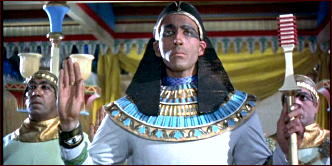
Over the past fifteen years or so, film and television writers have embraced both fanged vampires and, to a lesser extent, furry werewolves. With the exception of The Mummy (1999) and the franchise it launched, mummies, those aristocrats ensconced in linen and raised from the dead, have not played prominent roles as villains. This is unfortunate.
Not only are mummy tales, when critically unwrapped and analyzed, as terrifying as vampire yarns. They also provide a fascinating insight into how Anglo-American filmmakers have understood their particular era’s relationship to the ancient Egyptian past. From Napoleon Bonaparte’s first campaign in Egypt (1798) and British Museum’s Rosetta Stone exhibit (1802-present) to the discovery of Tutankhamun’s tomb (1922), the mysteries of long-vanished Egyptian civilizations have piqued the curiosity of western observers.
Mummy films are the cinematic representations of this strange, enduring fascination. The two best-known mummy films are undoubtedly Universal’s The Mummy (1932) starring Boris Karloff and the aforementioned 1999 quasi-remake starring Brendan Fraser and Rachel Weisz.
But there’s also a 1959 mummy film that deserves ample consideration. The Mummy, starring Peter Cushing, Christopher Lee, and Yvonne Furneaux, is perhaps the least known of the three films of the same name. To varying degrees, the plot is borrowed from three previous, even lesser known, mummy movies, The Mummy’s Hand (1940), The Mummy’s Tomb (1942), and The Mummy’s Ghost (1944). Directed by Terence Fisher, The Mummy (1959) is a Technicolor Hammer Production with great horror film acting, lavish and colorful settings, and an excellent, memorable score composed by Franz Reizenstein.
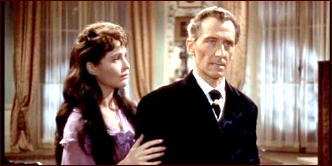
The film begins with an archaeological dig in Egypt. It’s 1895 and three members of the same family discover the tomb of Princess Ananka, the high priestess of the ancient Egyptian deity, Karnak. Because John Banning (Peter Cushing) is injured and somewhat immobile, the English archeologist’s father, Stephen Banning (portrayed by Felix Aylmer), is tasked, along with his uncle Joseph Whemple (Raymond Huntley), with entering the tomb.
Along comes Mehemet Bay in a red fez (portrayed by the Cypriot character actor George Pastell). He warns the two men against disturbing the dead, lest they unleash a curse against desecrators. As you might imagine, the enterprising Englishmen don’t heed the warnings of this excitable foreign fellow.
Skip to three years later. It’s 1898 and Stephen Banning is back in England. Sadly, the poor chap’s gone completely mad. His son, the scholarly John Banning, is now ambulatory and living with his wife (Yvonne Furneaux). Life is apparently pretty good for the younger Banning, who appears to be living a plush life on an English country estate.
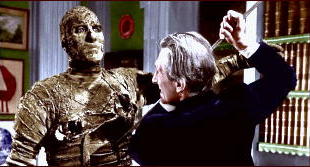
But good things never seem to last for those who disobey warnings not to disturb the dead. We know that there’s trouble ahead when Mehemet Bay arrives in England on a quest to avenge the opening of Princess Annaka’s tomb. After Stephen Banning is found dead in his room (murdered by the mummy Kharis), a police inspector by the name of Mulrooney begins to investigate the mysterious goings on.
Through extensive flashback scenes narrated by Peter Banning (Cushing in a quite memorable voice-over role within the film), we learn that Kharis (Lee) was the high priest of Karnak. Centuries ago, Egyptian authorities mummified Kharis and buried him alive as punishment for his attempt to bring Princess Annaka (also portrayed by Yvonne Furneaux), whom he loved, back from the dead.
The second half of the film revolves around Mehemet Bay’s attempt to utilize Kharis to kill the other two Bannings before heading back to his native Egypt. There’s a notable scene in which Peter Banning and Mehemet Bay tensely discuss the ethics of archeology, perhaps a subtext about London’s historical meddling in Egyptian affairs.
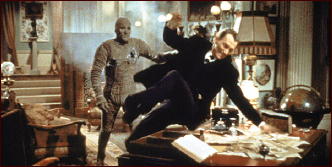
If the plot sounds somewhat convoluted, you’ll have to trust me both when I say that it’s really not and, even if it were, it really wouldn’t matter all that much. In many ways, plot isn’t what makes this version of The Mummy a classic horror film worth watching at least once.
It’s the filmmakers’ skillful use of color and lighting, particularly when combined with Reizenstein’s score, which transforms a film with an otherwise standard mummy-seeks-revenge plot into a captivating cinematic experience. Although the Egyptian scenes are clearly sets and not filmed on location, there’s something about them that makes them incredibly vivid.
One final note: while watching The Mummy on DVD, I kept thinking how much I’d like to see the film in a dark movie theater, particularly one with a great sound system. Who knows? Maybe some day, I shall.
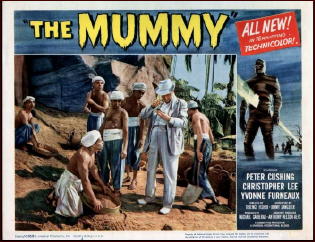
May 2nd, 2014 at 3:58 pm
I enjoyed Hammer’s Mummy films, this one particularly, but also The Curse of the Mummy (Terence Morgan, Ronald Howard, and the great Fred Clark), and Blood on the Mummy’s Tomb, easily their best based on Bram Stoker’s Jewel of the Seven Stars.
The franchise didn’t take off that well, probably because up until recent films you only had to walk fast to avoid lumbering, lurching, one arm tied up, mindless mummy’s. Notably Karloff in the Karl Frend original is only seen in the wrappings at the films beginning. The mummy was a bit more limber played by Tom Tyler, but Lon Chaney Jr. looked as if you could get him winded after a few yards.
I’ve always like mummy films though, and find both the best of the Universal and the Hammer films underrated.
May 2nd, 2014 at 4:34 pm
In this film, the first person that Kharis murders is the older Banning and that’s when the guy’s in his chamber and is already out of his mind. An easy target, one might say.
It’s been a while since I saw the 1999 version, but I seem to recall that mummy being a much more formidable foe.
But still, I liked this version a lot. I think it’s been highly underappreciated
May 2nd, 2014 at 7:03 pm
1) The color in those Hammer Films is positively sensuous, and this is one of the best.
2)Lee, Cushing and Aylmer were all in Olivier’s HAMLET (1948)and found themselves together again 11 years later here. Wonder what went through their minds?
3)I’ve always considered Karloff’s THE MUMMY (1932) one of the Great Romantic Films.
May 3rd, 2014 at 6:06 am
I didn’t know that about Hamlet. Amazing.